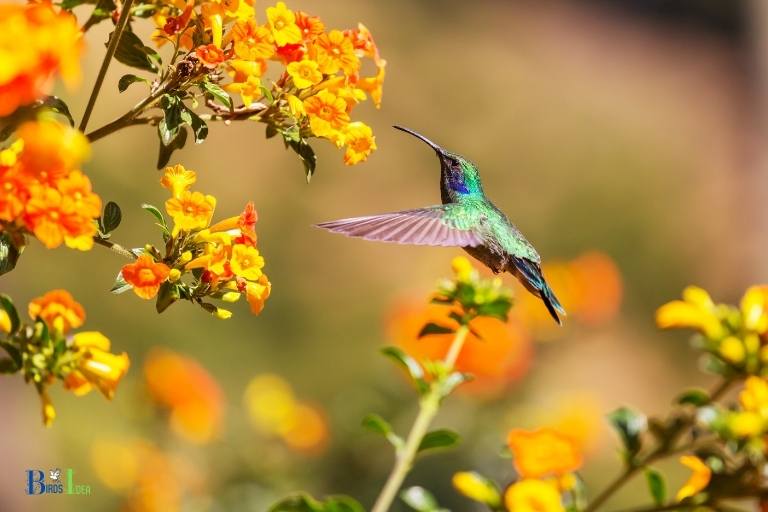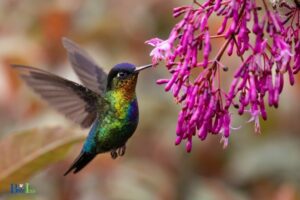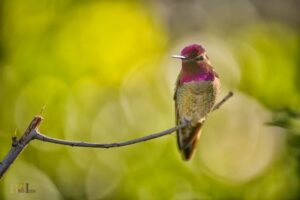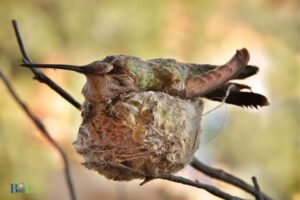How to Keep Hummingbird Nectar Fresh: Simple Steps!
To keep hummingbird nectar fresh, store it in a clean, cool environment, change it regularly, and clean the feeder frequently.
Hummingbird nectar is a sugar solution that provides essential energy for these small, high-energy birds. Keeping nectar fresh and clean is crucial to ensure hummingbirds stay healthy and continue to visit your feeder.
Storing nectar properly, changing it regularly, and cleaning the feeder frequently will help prevent bacterial and mold growth, which can be harmful to hummingbirds.
To ensure the nectar remains fresh and appealing to hummingbirds, always store any unused portion in the refrigerator. This slows down the fermentation process and helps keep it fresh for up to two weeks.
Consider using a clean and airtight container for storage to prevent contamination. Moreover, avoid adding food coloring or artificial sweeteners to the nectar, as they can be harmful to the birds.
By maintaining a clean and fresh hummingbird feeder, you provide a healthy and attractive environment for these fascinating creatures.
7 Actions to Keep Hummingbird Nectar Fresh
| Action | Details |
| Prepare nectar | Mix 1 part granulated sugar with 4 parts water. Boil the mixture to dissolve the sugar and remove impurities. Allow it to cool before filling the feeder. |
| Use proper feeder | Choose a feeder that is easy to clean and has a red color to attract hummingbirds. It should also have a tight seal to prevent leaks and protect the nectar from insects. |
| Clean feeder regularly | Clean the feeder with hot water and a soft brush every 3-4 days. Avoid using soap or bleach as they can leave harmful residues. Refill with fresh nectar after cleaning. |
| Store nectar properly | Keep unused nectar in an airtight container in the refrigerator for up to one week. Discard if the mixture becomes cloudy or starts to ferment. |
| Replace nectar | Replace the nectar in the feeder every 3-4 days during hot weather or once a week during cooler temperatures. This will prevent spoilage and keep it safe for the hummingbirds to consume. |
| Avoid direct sunlight | Place the feeder in a shady area of your garden, away from direct sunlight. This will help slow down the fermentation process and keep the nectar fresh longer. |
| Monitor feeder | Regularly check the feeder for mold, debris, or insects. Clean it thoroughly and refill with fresh nectar if any contaminants are found. |
Key Takeaway

Five Facts About: Keeping Hummingbird Nectar Fresh
Factors That Contribute To Stale Hummingbird Nectar
Hummingbirds are beautiful and delightful visitors in our gardens. They need to feed frequently to maintain their energy levels for their active lifestyle.
However, the hummingbird nectar can go stale quite quickly, and knowing the factors that contribute to its freshness is vital for their well-being.
Here are some things to consider.
The Impact Of Sunlight On Nectar Quality
Hummingbird feeders are best placed in the shade to avoid the direct sunlight, which can significantly impact nectar quality. Sunlight can cause the growth of bacteria and yeast in the nectar, which can be harmful to hummingbirds.
Here are the key points to keep in mind:
- Place the hummingbird feeder in a shaded area.
- Avoid placing the feeder in direct sunlight for extended periods.
- Change the nectar frequently, at least twice a week in hot temperatures.
The Role Of Temperature On Nectar Freshness
Temperature plays a crucial role in the nectar’s freshness, and high temperatures can cause the nectar to ferment quickly. In contrast, low temperatures slow down the fermentation process, making the nectar last longer.
Here are some temperature-related factors to remember:
- Change the nectar frequently, at least twice a week in hot temperatures.
- During the hot weather, consider changing the nectar daily.
- If the nectar becomes cloudy, it is past its prime and needs frequent changing.
The Impact Of Moisture On Nectar Freshness
Humidity and rain can also contribute to the nectar’s freshness, and moisture can promote bacterial growth.
For instance, if the feeder has leaks, it can allow water to mix into the nectar, promoting bacterial or fungal growth, which can be harmful to hummingbirds.
Here are some points on moisture in nectar:
- Ensure that the feeder has no leaks to prevent moisture from mixing with the nectar.
- Do not refill the feeder entirely since it can cause leftover nectar to spoil.
- Clean the feeder before refilling to get rid of any bacteria that might have grown.
Overall, taking proper care of the hummingbird nectar is essential to maintaining healthy hummingbird populations around your garden or backyard.
Always ensure that the nectar is fresh, avoid placing your feeder in direct sunlight, consider changing the nectar frequently, and clean the feeder before refilling.
These simple tips can make a huge difference in preserving the hummingbirds’ health and beauty.
Tips On How To Keep Hummingbird Nectar Fresh
Choosing The Right Feeder Types For Nectar Freshness
Hummingbirds love to drink fresh nectar, and choosing the right feeder can make all the difference in the world.
To keep nectar fresh, consider the following types of feeders:
- Saucer-type feeders: These feeders are great for attracting hummingbirds because the nectar is shallow. Hummingbirds can easily drink the nectar, reducing waste.
- Bottle-type feeders: Bottle-type feeders are more difficult to clean, but they are great for keeping nectar fresh. They have a small opening that reduces the amount of air that gets into the feeder, keeping the nectar fresh for a longer period.
The Impact Of Proper Cleaning And Maintenance On Nectar Freshness
To keep nectar fresh, it’s essential to properly clean and maintain the feeder.
The following tips can help:
- Change nectar frequently: Nectar can go bad quickly, so it’s essential to change it frequently—usually every 3 to 5 days.
- Clean the feeder: Hummingbirds are attracted to clean feeders. To properly clean the feeder, use a brush and hot, soapy water to remove mold and debris. Rinse the feeder thoroughly before refilling it.
- Disinfect the feeder: To disinfect the feeder, use a solution of 1-part white vinegar to 4-parts water, and rinse thoroughly.
Tips For Reducing Nectar Waste To Keep Nectar Fresh
Reducing nectar waste is an essential step in keeping nectar fresh.
The following tips can help:
- Use the right amount of nectar: To avoid waste, only use the amount of nectar that hummingbirds will drink in a few days.
- Place the feeder in the right location: Place the feeder in a shaded area to reduce exposure from the sun, which can cause the nectar to go bad quickly.
- Keep ants away: Ants love nectar, and they can quickly cause the nectar to go bad. To keep ants away, use an ant moat or place a ring of petroleum jelly around the hanger to prevent ants from reaching the nectar.
By following these tips, you can keep hummingbird nectar fresh and attract hummingbirds to your yard all season long.
Diy Nectar Recipes For Maximum Freshness
Hummingbirds are fascinating tiny creatures that bring joy and harmony to anyone’s garden. However, keeping their nectar fresh can be a real challenge. Hummingbird feeders attract bees and ants and the nectar spoils quickly in hot temperatures.
So, it’s essential to learn how to make homemade nectar and keep it fresh for your feathered friends.
In this section, we’ll discuss the benefits of making homemade nectar, provide a simple recipe for making nectar at home, and offer other nectar recipes to try for maximum freshness.
A Discussion On The Benefits Of Making Homemade Nectar
Making your hummingbird nectar has several advantages over store-bought nectar.
Here are a few benefits of diy hummingbird nectar recipes:
- You can control the ingredients and quality of the nectar.
- Homemade nectar is free of food colouring, preservatives, and other harmful chemicals.
- You can make small batches of nectar to avoid waste and ensure freshness.
- Homemade nectar is economical and easy to make.
A Simple Recipe For Homemade Hummingbird Nectar
Making hummingbird nectar at home is simple and requires only two ingredients.
Follow this recipe to make sweet nectar that hummingbirds will love:
- Mix one part sugar with four parts boiling water.
- Stir the mixture until the sugar dissolves entirely.
- Let the nectar cool down before filling the feeder.
- Store the excess nectar in a covered container in the refrigerator for up to two weeks.
Other Homemade Nectar Recipes To Try For Maximum Freshness
If you want to add flavour to your hummingbird feeder, you can try these homemade nectar recipes.
- Mint nectar: Add four fresh mint leaves to the boiling water before mixing it with sugar. Strain before using.
- Cinnamon nectar: Add two cinnamon sticks to the boiling water and stir until the sugar dissolves. Remove the cinnamon sticks before using.
- Elderflower nectar: Add two elderflower heads to the boiling water and let them infuse for a few hours. Strain before using.
- Orange blossom nectar: Add 1/4 teaspoon of orange blossom water to one cup of nectar.
Now that you have several homemade nectar recipes to try, you can keep your hummingbird feeder fresh and full of delicious nectar. With these tips, you can ensure your garden is a haven for these delightful creatures.
FAQ For How To Keep Hummingbird Nectar Fresh
How Often Do I Need To Change My Hummingbird Nectar?
Can I Use Tap Water For Preparing Hummingbird Nectar?
What Should I Do If My Hummingbird Nectar Turns Cloudy?
How Can I Keep Ants And Bees Away From My Hummingbird Feeder?
Can I Add Food Coloring To My Hummingbird Nectar?
Conclusion
As hummingbirds are a joy to watch and bring a touch of beauty to any garden or backyard, it is important to ensure that their nectar remains fresh. By following the tips outlined in this article, you can keep your hummingbird feeder clean and free from harmful mold and bacteria.
Remember to change the nectar at least once a week, clean the feeder thoroughly, and place it in a shaded area to prevent spoilage. Additionally, using homemade nectar without any artificial dyes or preservatives will not only be healthier for the birds but also for the environment.
So next time you watch a hummingbird sip from its feeder, take pride in knowing that you are providing a safe and healthy environment for these beautiful creatures to thrive in, all while enjoying their captivating presence.






